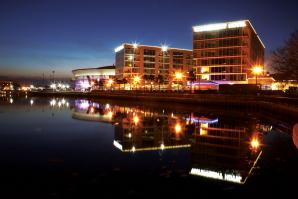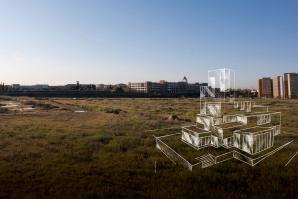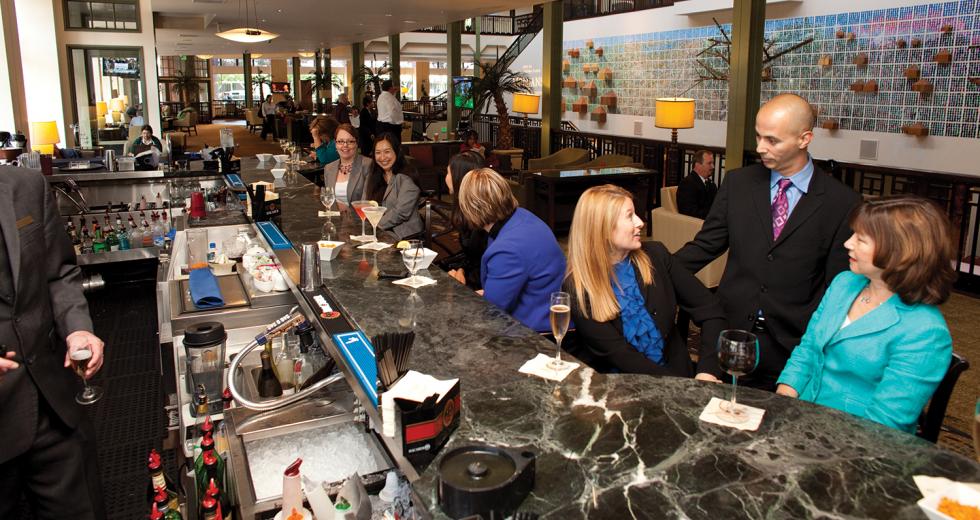When Meg Whitman arrives in Sacramento to campaign for the gubernatorial race, she stays at the Citizen Hotel. “It’s her home away from home,” says Mark Mathews, the hotel’s general manager.
That doesn’t mean the Joie de Vivre property is picking sides. “We are bi-partisan. We poke fun at all parties,” he says, referencing the satirical political graphics that fill the hotel, including a larger-than-life photo of the governor in his Speedo-clad weightlifting days that lives in a ladies’ restroom.
The hotel, which opened in November 2008 in the renovated 1920s Cal Western Life building, was designed to attract the Capitol crowd, lobbyists and lawmakers just a couple blocks away.
But management has had to get creative to fill the 198 guestrooms. Last April, Sacramento saw a 25 percent decline in year-over-year revenue per room, according to Smith Travel Research, a hotel industry consulting company. “That completely threw off the assumptions made when this was being developed,” Mathews says.
San Francisco-based Joie de Vivre changed the management structure and didn’t hire as many workers as planned. Business development staff began to court group sales, though the original model relied more on individuals — or as it is known in the industry, transients — and less on filling large meeting spaces. Weddings became a bigger part of the business plan along with special rates for frequent business travelers.
One special that brought visitors through the door was a $99 offer for locals within a 40-mile radius looking for a “staycation.”
“We even started playing with online discount travel sites,” Mathews says.
The Citizen’s occupancy is up 5 percent, Mathews says, but room prices are down. “But it is a slippery slope and we don’t want to go too far down [in price],” Mathews says.
Business is coming back, says Lynn Mohrfeld, president and CEO of the California Hotel & Lodging Association. “Businesses realize they can’t stop traveling and meeting, especially when there are so many deals to be had.”
The Citizen recently lost a bid to Holiday Inn Sacramento Capitol Plaza for a contract to serve Southwest Airlines employees. “It was a great business to have, but not at that price,” Mathews says.
Instead, Joie de Vivre is investing in Joie Connect, a program that includes Apple Mac mini computers in every room connected to large flat-screen televisions for integrated work and entertainment without taking laptops through airport security. “It is the complete experience,” Mathews says.
Last April, Sacramento saw a 25 percent decline in year-over-year revenue per room.
Smith Travel Research
Also rounding out the Citizen’s offerings is the Grange restaurant, which has scored rave reviews for chef Michael Tuohy’s locally sourced, all-natural menu. The restaurant has exceeded expectations, Mathews says. The bar is often crowded during happy hour and into the night, while the dark-paneled registration desk on the other side of the building stands empty.
Four blocks up J Street, the Sheraton Grand has seen a similar pattern with a busy bar and slow registration desk. “The cancellation calls started coming at the end of 2008,” says Margie Starr, director of sales and marketing for the Sheraton Grand.
“Business in the bar never did drop off,” Starr adds. “People still drink.”
About half of the Sheraton’s business are groups and half are transients. Both segments took a hit.
Groups that held annual events were not able to book enough rooms to meet their contractual commitments. “We were flexible and worked as partners to build loyalty instead of holding them to a contract,” Starr says.
The good news about booking rooms for a hotel in a state capital is that associations have to hold their annual meetings regardless of the economy. It’s in their bylaws, but members don’t have to attend. That meant that in 2009, some of the larger groups weren’t so large.
Starr shifted strategy and started booking conferences with groups that might not otherwise have come to Sacramento.
For it’s part, the Sacramento Convention and Visitor’s Bureau also started focusing on some untraditional groups. “We continue to leverage our city’s brand as a good value destination while targeting ‘recession-proof’ industries, such as alternative energy organizations, for new convention business,” says President and CEO Steve Hammond. One early success was the booking of a biomass group that was finalized in the first quarter. Hammond also identified health care and urban development as possible growth areas based on the attributes and strengths of the Sacramento area.
Because the state was in a cutting mode rather than a spending mode, transient sales were also down as lobbyists also took a hit in revenue.
The hotel cut expenses where it could, but did not lay anyone off or change the visitor experience. “We are in business for the long haul, so we don’t want to cheapen the experience in any way,” Starr says.
Mohrfeld of the California Hotel & Lodging Association says the Sheraton is indicative of the way a lot of operators responded. It retooled operations to get more efficiency, working with vendors to negotiate better pricing on everything from human resources training to trash pick up and insurance.
Sheraton Grand owner, Starwood Hotels, took the downturn as an opportunity to invest $5 million in updating the rooms and lobby. “It was a great opportunity while we had access to the rooms,” Starr says.
“We continue to leverage our city’s brand as a good value destination while targeting ‘recession-proof’ industries.”
Steve Hammond, president and CEO Sacramento Convention and Visitor’s Bureau
In the first quarter of 2010, some conferences that had scaled back, started to show attendance that was higher than expected. Starr expects the growth curve will be a slow incline as vendors have learned to work with less. “We have nowhere to go but up,” she says.
At the Sacramento Marriott in Rancho Cordova, business was increasing in May after taking a dive the previous summer. “It was pretty bad,” says Toby Valdez, director of sales. Both group and transient occupancy was still down from the previous year. However, the second quarter seemed to be moving in the right direction, thanks in part to the weekend demand during Regatta Month at the Aquatic Center.
Midweek, the lobby is home largely to business travelers from Intel, Aerojet and VSP. While the Marriot is one of the only hotels in the area with large meeting space, competition with the new hotels that have gone up on Zinfandel in the past year has been tough, according to Valdez. “It doesn’t help that we have all this additional supply,” Valdez says.
In May, the Folsom City Council approved a 109-room hotel development by Alleghany Properties that would add to the capacity in the Highway 50 corridor.
Valdez transferred to Sacramento from the Fisherman’s Wharf Marriott in November and predicted that the upward trend in occupancy rates that seemed to be moving west would come back to Sacramento now that it has reached San Francisco.
The individual hotel operators’ anecdotes mirror statistics identified by Smith Travel Research. According to a February 2010 report, Sacramento County’s occupancy rate was 57.4 percent, up from 46.5 percent in December. That is still well below the 69 percent out of 13,121 rooms surveyed in February of 2006. A look at Placer, El Dorado, San Joaquin and Solano counties show similar trends, ranging from 43 to 49 percent.
Smith President Mark Lomanno predicts the upward trend will continue with occupancy increases of almost 2 percent. “We think the recovery will pick up its pace during the second and third quarters of this year, then it will moderate,” Lomanno says.
Recommended For You

Waterfront Shack-Up
Students move in at Stockton's premier hotel
Forget books, exams and professors. The campus buzz at Stockton’s University of the Pacific is about the hottest new idea in off-campus housing: Lofts at the University Plaza Waterfront Hotel.

Center of Attention
Is a conference center what Placer County really needs?
Roseville may be contemplating — again — plans to build a long-coveted conference center. The city has for years touted the benefits of a civic center, but such projects are notorious for their inability to bring in hefty, consistent revenue, and plenty of people are wondering if the right time for such a gamble is now.



